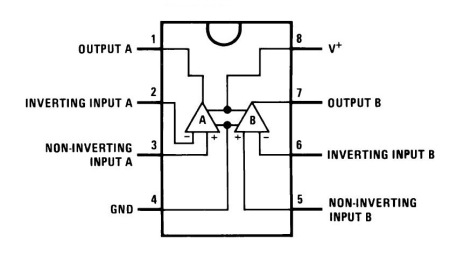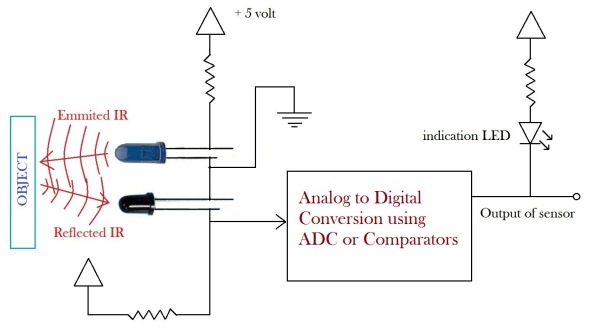 This Sensor module works on the principle of Reflection of Infrared Rays from the incident surface. A continuous beam of IR rays is emitted by the IR LED. Whenever a reflecting surface (white/obstacle) comes in front of the Receiver (photo diode), these rays are reflected back and captured. Whenever an absorbing surface (Black/No Obstacle) comes in front of the Receiver, these rays are absorbed by the surface and thus unable to be captured.
This Sensor module works on the principle of Reflection of Infrared Rays from the incident surface. A continuous beam of IR rays is emitted by the IR LED. Whenever a reflecting surface (white/obstacle) comes in front of the Receiver (photo diode), these rays are reflected back and captured. Whenever an absorbing surface (Black/No Obstacle) comes in front of the Receiver, these rays are absorbed by the surface and thus unable to be captured.
FEATURES:
- Active Low on object detection
- 3 pin easy interface connector
- Indicator LED
- Potentiometer for changing the range of detection
Applications:
- Line Follower sensor
- Obstacle Avoidance Robot
- Edge avoiding robot
- Anti-falling robot
- Light/Fire sensing
Basic Block Diagram:
IR LED:

IR LED is used in this circuit to transmit infrared light.
An Infrared light-emitting diode (IR LED) is a type of electronic device that emits infrared light not visible to the naked eye.
The wavelength and colour of the light produced depend on the material used in the diode. Infrared LEDs use material that produces light in the infrared part of the spectrum, that is, just below what the human eye can see. Different infrared LEDs may produce
infrared light of differing wavelengths, just like different LEDs produce light of different colours.
Since the human eye cannot see the infrared radiations, it is not possible for a person to identify whether the IR LED is working or not, unlike a common LED. To overcome this problem, the camera on a cell phone can be used. The camera can show us the IR rays being emanated from the IR LED in a circuit.
Photo-diode:

Here Photo diode is used to capture reflected light of IR LED.
A semiconductor diode that, when exposed to light, generates a potential difference or changes its electrical resistance.
A Photo diode is a reverse biased silicon or germanium pn junction in which reverse current increases when the junction is exposed to light.
When no light is incident on the pn junction of photo diode, the reverse current is extremely small. This is called DARK CURRENT.
When light is incident on the pn junction of the photo diode there is a transfer of energy from the incident light (photons) to the atoms in the junction .this will create more free electrons (and more holes) these additional free electrons will increase the reverse current.This electrical energy can be recorded as voltage drop fluctuations by using a series resistor in the outer circuit and taking voltage readings across it.
.
Analog to Digital Converter:
It is clear that the output of the Photo diode is an analog voltage. If you want to use this sensor as an analog output sensor then there is no need to use any comparator. We can give this analog value directly to Microcontroller’s ADC pin.

Some Microcontrollers do not have ADC peripheral (For example 8051) and also sometimes we want to feed pre-processed data to microcontroller (Hardware/Software trade off). So if you want digital output from this sensor, we can use Comparator for that.
.

.
V0 = High when V+ > V-
V0 = Low when V+ < V-
.
.
FUNCTION OF THE COMPARATOR:

LM-358 (Op-Amp IC):
The LM-358 IC consists of two independent operational amplifiers which were designed specifically to operate from a single power supply over a wide range of voltages.
Here Op-amp is used as comparator.
Pin configuration of LM-358 is giving as follows-

LED:
One Light Emitting Diode is used in this circuit for indicating the output logic of this IR sensor.
More Images:

Schematic:
PCB Layout: 
1. Bottom Copper Layer- 2. Silk Screen Layer – 3. Bottom & Silk screen layer-
Please write comments if you find anything incorrect, or you want to share more information about the topic discussed above.





